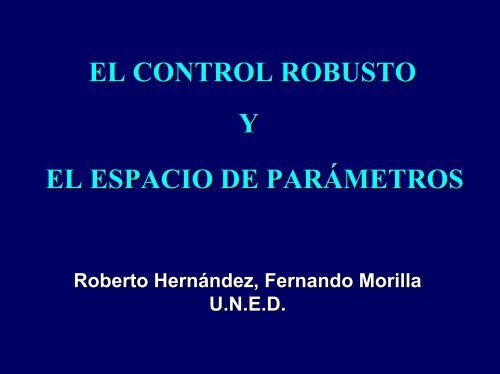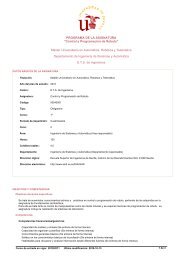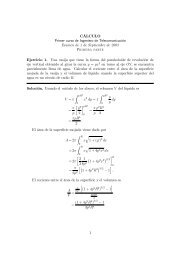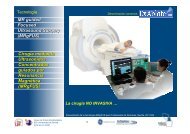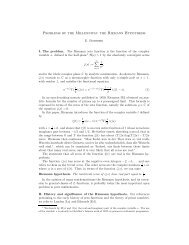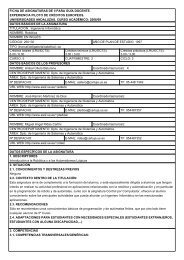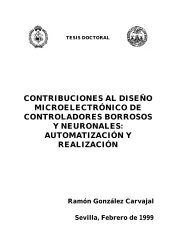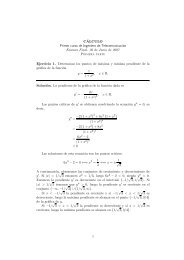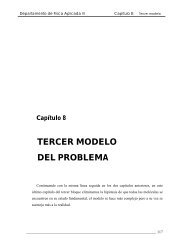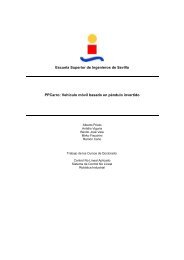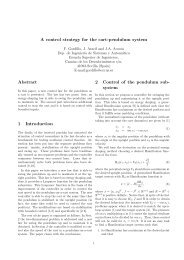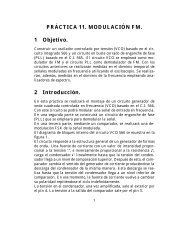El Control Robusto y el espacio de parámetros
El Control Robusto y el espacio de parámetros
El Control Robusto y el espacio de parámetros
You also want an ePaper? Increase the reach of your titles
YUMPU automatically turns print PDFs into web optimized ePapers that Google loves.
EL CONTROL ROBUSTO<br />
Y<br />
EL ESPACIO DE PARÁMETROS<br />
Roberto Hernán<strong>de</strong>z, Fernando Morilla<br />
U.N.E.D.
RESULTADOS DE PUNTOS EXTREMOS<br />
Teorema <strong>de</strong> Kharitonov, , 1978: intervalo <strong>de</strong> polinomios.<br />
1 2<br />
2<br />
n<br />
PI(, s q)<br />
= q0 + qs<br />
1<br />
+ q2s + L + qns<br />
n<br />
− +<br />
K<br />
n i i i<br />
q= ( q , q , , q ) ∈R , q ∈[ q , q ]<br />
Necesario y suficiente: 4 polinomios distinguidos.<br />
− +<br />
i i i<br />
0 < q ≤ q ≤ q<br />
− − +<br />
1 0 1 2 2 +<br />
3 3 −<br />
4 4 −<br />
5 5 +<br />
6 6<br />
K ( s) = q + q s+ q s + q s + q s + q s + q s + ...;<br />
+ + −<br />
2 0 1 2 2 −<br />
3 3 +<br />
4 4 +<br />
5 5 −<br />
6 6<br />
K ( s) = q + q s+ q s + q s + q s + q s + q s + ...;<br />
+ − −<br />
3 0 1 2 2 +<br />
3 3 +<br />
4 4 −<br />
5 5 −<br />
6 6<br />
K ( s) = q + q s+ q s + q s + q s + q s + q s + ...;<br />
<br />
− + +<br />
4 0 1 2 2 −<br />
3 3 −<br />
4 4 +<br />
5 5 +<br />
6 6<br />
K ( s) = q + q s+ q s + q s + q s + q s + q s + ...;<br />
Olbrot, , 1983. Barmish.<br />
<br />
CONTROL ROBUSTO: mod<strong>el</strong>o <strong>de</strong> perturbaciones.<br />
<br />
Estructuradas: se establecen en los parámetros <strong>de</strong> la planta.
∀n<br />
• y se evita <strong>el</strong> mallado clásico<br />
• Extensión a otros casos: discreto, comportamiento robusto, ...<br />
■ POLITOPOS<br />
RESULTADOS DE PUNTOS EXTREMOS<br />
psq (, ) = s + a()<br />
qs<br />
Los coeficientes <strong>de</strong>pen<strong>de</strong>n <strong>de</strong> forma afín lineal <strong>de</strong> q<br />
n<br />
n−1<br />
∑<br />
i=<br />
0<br />
i<br />
i<br />
Teorema <strong>de</strong> la Arista, Teorema <strong>de</strong> Rantzer<br />
ANÁLISIS: TEORÍA MADURA<br />
(Barmish, 1993)<br />
(Ackermann, 1993)<br />
OBJETIVO: RESULTADOS PARA EL PROBLEMA DE DISEÑO
RESULTADOS DE PUNTOS EXTREMOS<br />
<br />
Paradigma <strong>de</strong> intervalo <strong>de</strong> plantas:<br />
⎧⎪<br />
N (, s b)<br />
P= Psab (, , ): Psab (, , ) = , N (, sb) ∈N, D(, sa)<br />
∈D<br />
⎪⎩<br />
p<br />
I ⎨<br />
p<br />
I P<br />
I<br />
Dp(, s a)<br />
ut ()<br />
+<br />
-<br />
Cs () =<br />
Nc()<br />
s<br />
D () s<br />
c<br />
Cs () P (, sab , )<br />
I<br />
y()<br />
t<br />
⎫⎪<br />
⎬<br />
⎪⎭<br />
δ ()= s N () s N (, s b) + D () s D (, s a)<br />
I<br />
c p c p<br />
Politopo
RESULTADOS DE PUNTOS EXTREMOS<br />
<br />
<br />
<br />
<br />
<br />
<br />
Resultados previos:<br />
Ghosh, 1985: <strong>Control</strong>adores positivos, 4 polinomios.<br />
Chap<strong>el</strong>lat-Bhattacharyya, 1989: 32 aristas distinguidas.<br />
Hollot y Yang, 1990: <strong>Control</strong>adores <strong>de</strong> 1er or<strong>de</strong>n. Todas<br />
las plantas extremas.<br />
Barmish et al., 1992: <strong>Control</strong>adores <strong>de</strong> 1er or<strong>de</strong>n. 16 plantas<br />
<strong>de</strong> Kharitonov.<br />
Djaferis, 1993: 64 polinomios virtuales.
RESULTADOS DE PUNTOS EXTREMOS<br />
<br />
Hernán<strong>de</strong>z<br />
n<strong>de</strong>z et al., 1995: 32 polinomios virtuales.<br />
Se construyen en función n d<strong>el</strong> controlador y <strong>de</strong> los polinomios <strong>de</strong><br />
Kharitonov d<strong>el</strong> numerador y d<strong>el</strong> <strong>de</strong>nominador <strong>de</strong> la planta.<br />
Propieda<strong>de</strong>s y conservadurismo.<br />
<br />
<br />
Hernán<strong>de</strong>z<br />
n<strong>de</strong>z et al., 1996, Hernán<strong>de</strong>z<br />
n<strong>de</strong>z et al., 1998: Generalización<br />
d<strong>el</strong> menor intervalo <strong>de</strong> polinomios que contiene al politopo <strong>de</strong><br />
polinomios.<br />
Hernán<strong>de</strong>z<br />
n<strong>de</strong>z et al., , 1999: : Generalización <strong>de</strong> los polinomios <strong>de</strong><br />
Bialas, , conservadurismo.
RESULTADOS DE PUNTOS EXTREMOS<br />
<br />
<br />
CONCLUSIÓN: RPE PARA INTERVALO DE PLANTAS.<br />
PROBLEMA: ESTABILIZAR UN POLINOMIO.<br />
p()<br />
s<br />
n<br />
= ∑cs<br />
i<br />
i=<br />
0<br />
i<br />
p(<br />
s,<br />
k)<br />
=<br />
∑<br />
∀i<br />
/ i∈A<br />
a s<br />
i<br />
i<br />
+<br />
∑<br />
∀i<br />
/ i∈K<br />
k<br />
i<br />
s<br />
i<br />
<br />
<br />
Coeficientes constantes:<br />
Parámetros:<br />
A<br />
K<br />
{ a = c c = const}<br />
i i i<br />
{ = ≠ }<br />
= /<br />
= k c / c<br />
i<br />
i<br />
i<br />
const<br />
OBJETIVO: : Determinar K, , si existe, tal que p(s,k) sea estable<br />
<br />
ROUTH: 2 parámetros<br />
Necesidad <strong>de</strong> resultados en <strong>el</strong><br />
<strong>espacio</strong> <strong>de</strong> parámetros.
ESPACIO DE PARÁMETROS<br />
<br />
<br />
RESULTADOS OBTENIDOS:<br />
Condiciones necesarias y suficientes para estabilizar un polinomio<br />
en <strong>el</strong> <strong>espacio</strong> <strong>de</strong> parámetros:<br />
EXISTENCIA DE SOLUCIÓN.<br />
<br />
ALGORITMO para obtener un CONJUNTO DE PARÁMETROS que<br />
estabiliza <strong>el</strong> polinomio.<br />
<br />
<br />
Válido para cualquier or<strong>de</strong>n y cualquier nº n <strong>de</strong> parámetros.<br />
Resu<strong>el</strong>ve <strong>de</strong> forma inmediata cuando n < 12 y 4 parámetros.
ESPACIO DE PARÁMETROS<br />
<br />
<br />
EN LA ACTUALIDAD:<br />
ALGORITMO para obtener un CONJUNTO DE PARÁMETROS que<br />
estabiliza <strong>el</strong> POLITOPO DE POLINOMIOS.<br />
<br />
General.<br />
p(<br />
s,<br />
k)<br />
=<br />
∑<br />
∀i<br />
/ i∈A<br />
a s<br />
i<br />
i<br />
∑<br />
∀i<br />
/ i∈K<br />
b : función n lineal <strong>de</strong> los parámetros<br />
i<br />
+<br />
b<br />
i<br />
s<br />
i<br />
k i<br />
<br />
<br />
Desarrollando expresiones analíticas.<br />
Posible resolver cualquier problema particular.
CASO REAL: DOBLE ROTOR<br />
L h , ω h<br />
L v , ω v<br />
Y<br />
X<br />
Z
CASO REAL: DOBLE ROTOR<br />
<br />
1) AplicaciA<br />
plicación n <strong>de</strong> control monovariable.<br />
<br />
Se controla <strong>el</strong> ángulo <strong>de</strong> asiento (variable controlada) con la tensión al motor principal (variable manipulada):<br />
- manteniendo bloqueado <strong>el</strong> eje vertical o<br />
- consi<strong>de</strong>rando que la tensión al motor <strong>de</strong> cola actúa como variable <strong>de</strong> perturbación.<br />
<br />
Mod<strong>el</strong>o:<br />
( θ)<br />
( ) ( )<br />
G(s) o<br />
= a s 3 2<br />
3<br />
+ a s a θ s a θ<br />
2<br />
+<br />
1<br />
+<br />
o<br />
b<br />
θ = ángulo <strong>de</strong> asiento que <strong>de</strong>pen<strong>de</strong> d<strong>el</strong> punto <strong>de</strong> operación.<br />
140<br />
120<br />
100<br />
b 0<br />
80<br />
60<br />
40<br />
20<br />
0<br />
-45 -40 -35 -30 -25 -20 -15 -10 -5 0<br />
θ
CASO REAL: DOBLE ROTOR<br />
a 1<br />
a1<br />
2.55<br />
2.5<br />
2.45<br />
2.4<br />
2.35<br />
2.3<br />
2.25<br />
2.2<br />
2.15<br />
2.1<br />
2.05<br />
-45 -40 -35 -30 -25 -20 -15 -10 -5 0<br />
θ<br />
a 0<br />
1.75<br />
1.7<br />
1.65<br />
1.6<br />
1.55<br />
1.5<br />
1.45<br />
1.4<br />
1.35<br />
-45 -40 -35 -30 -25 -20 -15 -10 -5 0<br />
θ<br />
o<br />
<br />
Mod<strong>el</strong>o <strong>de</strong> incertidumbre: intervalo <strong>de</strong> plantas<br />
( ) ∈[ ]<br />
b θ 18.427, 137.9447<br />
o<br />
( ) ∈ [ ] a1( θ) ∈[ 2.0535, 2.5423]<br />
a θ 1.3993, 1.7407<br />
a2<br />
= 1,0711 a3<br />
= 1,4320<br />
1<br />
C(s) = K+ primer or<strong>de</strong>n 16 p. virtuales, diseño o no conservador.<br />
Ts<br />
i
CASO REAL: DOBLE ROTOR<br />
<br />
Planta con numerador <strong>de</strong> grado cero 8 plantas virtuales. . Solución.<br />
k<br />
0.01<br />
0.005<br />
0<br />
Asín<br />
k<br />
-0.006<br />
-0.007<br />
-0.008<br />
-0.009<br />
-0.005<br />
-0.01<br />
-0.015<br />
-0.02<br />
-0.025<br />
-0.01<br />
-0.011<br />
-0.012<br />
-0.013<br />
-0.014<br />
-0.015<br />
-0.016<br />
Zona <strong>de</strong> estabilidad<br />
Zona <strong>de</strong> estabilidad<br />
-0.03<br />
-5 0 5 10 15 20<br />
Ti<br />
x 10 4<br />
-3 -2 -1 0 1 2 3 4<br />
x 10 4<br />
Ti<br />
<br />
7 polinomios estables, y uno inestable.
CASO REAL: DOBLE ROTOR<br />
<br />
Posible mod<strong>el</strong>o conservador:<br />
Conocimiento <strong>de</strong> la planta r<strong>el</strong>ación n lineal entre a 0 y a 1 .<br />
<br />
Aproximación politópica<br />
pica <strong>de</strong> b 0 .<br />
Por ejemplo, si:<br />
los ocho polinomios.<br />
o<br />
( ) ∈[ ]<br />
b θ 18.427, 117.9447<br />
k<br />
se estabilizan<br />
<br />
Observaciones:<br />
1) k negativo pequeño<br />
-0.0105<br />
-0.011<br />
2) Ti gran<strong>de</strong><br />
3) Comportamiento ???<br />
-0.0115<br />
-0.012<br />
Zona <strong>de</strong> estabilidad<br />
-0.0125<br />
-6000 -4000 -2000 0 2000 4000 6000 8000 10000 12000<br />
Ti
CASO REAL: DOBLE ROTOR<br />
Un parámetro más: m<br />
PID académico:<br />
Diseño o conservador: 32 p. v. (16)<br />
K<br />
= + s P I D<br />
s<br />
I<br />
C(s) K<br />
P+ K<br />
D<br />
, K,K,K > 0<br />
Diseño o no conservador (8 vértices v<br />
+ aristas)<br />
2.5<br />
2<br />
kd=2;<br />
1.5<br />
Zona <strong>de</strong> estabilidad<br />
<strong>de</strong> los 8 vértices<br />
kp<br />
1<br />
0.5<br />
0<br />
-0.5<br />
-40 -20 0 20 40 60 80 100<br />
ki
CASO REAL: DOBLE ROTOR<br />
<br />
Aristas: casi toda la zona estabiliza las aristas.<br />
1)<br />
KD = 2;K<br />
P=1;KI<br />
= 5;<br />
800<br />
Conjunto <strong>de</strong> valores<br />
600<br />
400<br />
200<br />
0<br />
-200<br />
-400<br />
-12000 -10000 -8000 -6000 -4000 -2000 0 2000 4000
CASO REAL: DOBLE ROTOR<br />
60<br />
69.75<br />
40<br />
20<br />
0<br />
-20<br />
69.7<br />
69.65<br />
69.6<br />
-40<br />
69.55<br />
-60<br />
69.5<br />
-800 -600 -400 -200 0 200 400 600 800 1000<br />
618.5 619 619.5 620 620.5 621 621.5 622<br />
2)<br />
3)<br />
KD = 2;K<br />
P=1.4;KI<br />
= 0.1;<br />
KD = 2; K<br />
P=0.01; KI<br />
= 2.5;
CASO REAL: DOBLE ROTOR<br />
<br />
Comportamiento: D-estabilidad.<br />
<strong>El</strong> intervalo <strong>de</strong> plantas pue<strong>de</strong> convertirse en politopo:<br />
‣ Conservador en <strong>el</strong> mod<strong>el</strong>o<br />
‣ Conservador en <strong>el</strong> diseño o (menor coste computacional)<br />
<br />
<strong>Control</strong> multivariable: : más m s parámetros, más m s grado <strong>de</strong> los polinomios<br />
característicos.
OTROS ÁMBITOS<br />
<br />
<strong>Control</strong> Predictivo – politopos <strong>de</strong> plantas.<br />
Resultados <strong>de</strong> análisis:<br />
GPC δ(s) es un politopo <strong>de</strong> polinomios, aplicación RPE<br />
Mean lev<strong>el</strong>, Dead beat<br />
CRHPC menos robusto que GPC<br />
Influencia d<strong>el</strong> polinomio T en δ(s)<br />
<br />
Dinámicas rápidas r<br />
y lentas: Generalización n d<strong>el</strong> Teorema <strong>de</strong><br />
Kharitonov intervalos <strong>de</strong> polinomios que pue<strong>de</strong>n disminuir <strong>de</strong> grado.
REFERENCIAS<br />
• Ackermann J., in co-operation with Barlett A., Kaesbauer B., Sien<strong>el</strong> W., Steinhauser R., “Robust<br />
<strong>Control</strong>. System with Uncertain Physical Parameters”, , Springer-Verlag, 1993.<br />
• Barmish B.R., “New tools for Robustness of Linear Systems”, , Macmillan Publishing Company.<br />
1993.<br />
• Ghosh B.K., “Some New Results on the Simultaneous Stabilizability of a Family of Single Input,<br />
Single Output Systems”, , Systems and <strong>Control</strong> Letters, vol. 6, pp. 39-45, 1985.<br />
• Chap<strong>el</strong>lat H., Bhattacharyya S.P., ”A A Generalization of Kharitonov’s s Theorem: Robust Stability<br />
of Interval Plants”, , IEEE Transations on Automatic <strong>Control</strong>, vol. AC-34, # 3, pp. 306-311, 1989.<br />
• Hollot C.V., Yang F., ” Robust Stabilization of Interval Plants using Lead or Lag Compensators”,<br />
Systems and <strong>Control</strong> Letters, 14, pp. 9-12, 1990; Proc. of IEEE Conference on Decision and<br />
<strong>Control</strong>, Diciembre 1989, Tampa, Fl, 1990.<br />
• Barmish B.R., Hollot C.V., Kraus J.F., Tempo R., “Extreme Point Results for Robust<br />
Stabilization of Interval Plants with First Or<strong>de</strong>r Compensators”, , IEEE Transactions on<br />
Automatic <strong>Control</strong>, vol. AC 37, pp.707-714.<br />
• Djaferis T.E., “To Stabilize an Interval Plant Family it Suffices to Simultaneously Stabilize Sixty-<br />
four Polynomials”, , IEEE Transactions on Automatic <strong>Control</strong>, vol. 38, # 5, pp. 760-764, 1993.
REFERENCIAS<br />
• Hernán<strong>de</strong>z<br />
n<strong>de</strong>z et al., 1995. “On the Sixty-four Polynomials of Djaferis to Stabilize an Interval Plant”,<br />
IEEE Transactions on Automatic <strong>Control</strong>, Diciembre 1995<br />
• Hernán<strong>de</strong>z<br />
n<strong>de</strong>z et al., 1996. “Comparison between the Thirty-two Virtual Vertices and the Ghosh<br />
Polynomials to Stabilize an Interval plant”, 13 th Triennial World Congress, San Francisco, IFAC<br />
1996<br />
• Hernán<strong>de</strong>z<br />
n<strong>de</strong>z et al., 1998. “ On the Thirty-two Virtual Polynomials to Stabilize an Interval Plant”,<br />
IEEE Transactions on Automatic <strong>Control</strong>, Octubre 1998<br />
• Hernán<strong>de</strong>z<br />
n<strong>de</strong>z et al., , 1999. “Comparison between the Extreme Point Results to Stabilize an Interval<br />
Plant”, 14 th Triennial World Congress, Beijing, IFAC 1999<br />
• “Kharitonov´s Theorem Extension to Interval Polynomials Which Can Drop in Degree: A<br />
Nyquist approach”, IEEE Transactions on Automatic <strong>Control</strong>, Diciembre 1995<br />
<br />
Hernán<strong>de</strong>z R, Dormido S., “Kharitonov’s Theorem Extension for Interval Polynomials which<br />
Can Drop in Degree: A Nyquist Approach”, IEEE Transactions on Automatic <strong>Control</strong>, vol. 41, #<br />
7, pp. 1-4, Julio 1996.


